Weeds and Human Health
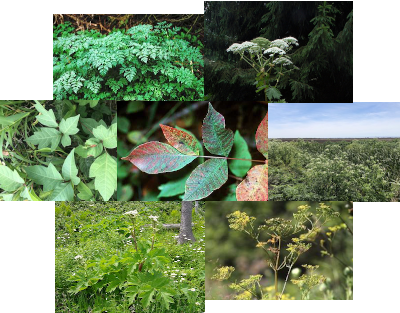 Learn how to identify and manage these poisonous plants.
Learn how to identify and manage these poisonous plants.
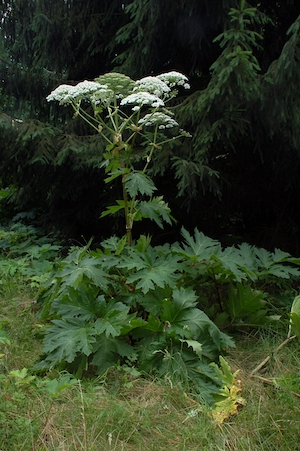 Giant hogweed (Heracleum mantegazzianum) is an invasive weed that can cause burns and scarring. The sap of giant hogweed contains furanocoumarins which can cause photodermatitis when combined with sunlight. Contact with the sap, through brushing against or breaking the plant, can cause severe
Giant hogweed (Heracleum mantegazzianum) is an invasive weed that can cause burns and scarring. The sap of giant hogweed contains furanocoumarins which can cause photodermatitis when combined with sunlight. Contact with the sap, through brushing against or breaking the plant, can cause severe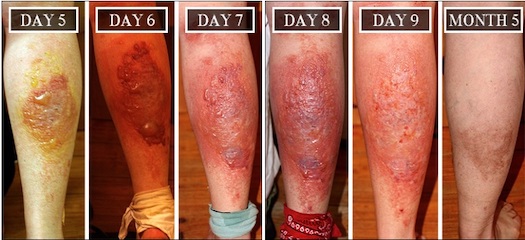
How to Identify
This large member of the carrot family (Apiaceae) is a biennial/perennial and can grow to over 14 feet tall. In addition, the leaves of giant hogweed can be up to 5 feet wide. It has hollow stems that range from 1.5 to 3 inches in diameter and are covered with hairs and reddish-purple splotches. Giant hogweed has white flowers and its inflorescence can be 2.5 feet across.
What to do if you encounter it
If you come into contact with giant hogweed, wash the affected area immediately with soap and cool water and keep the area away from sunlight for 48 hours. Contact your physician as soon as possible.
If you think you have giant hogweed on you property, do NOT touch it or try to remove it. Instead, identify the plant, take detailed photographs from a safe distance, and contact the NYS Department of Environmental Conservation (NYSDEC) through email (ghogweed@dec.ny.gov) or call the giant hogweed information line (845-256-3111).
Giant hogweed is a federally listed noxious weed. Its sale, import, purchase, transport, and propagation are prohibited under NYS law. For more information about giant hogweed, please visit its page on the NYSDEC website.
Management
Giant hogweed can be managed through cutting, mowing, and herbicide application. Whenever working near giant hogweed, wear protective clothing including long pants, a long-sleeve shirt, closed toed shoes, and gloves. When removing this plant, change clothes frequently and wash contaminated clothing separately.
Root cutting is best suited to controlling small patches on giant hogweed. To do so, cut the root about 6 to 10 inches below the soil surface and remove the aboveground portion from the roots. It is best to cut the roots before the leave become large. The the aboveground portion out in the sun to dry and/or bag and dispose of it. Additional cuttings may be necessry if the plant regrows. Herbicide can be applied to the cut roots to prevent regrowth.
Giant hogweed can also be managed through repeated mowing. Mowing is most effective when the plants are small. Do NOT mow after giant hogweed has flowerd, formed seed heads, or grown taller than the mower. Mow at least 3 times per season for multiple years for optimal results.
Herbicides offer another option to control giant hogweed. Systemic herbicides, such as glyphosate and triclopyr, effectively control giant hogweed. While glyphosate is a non-selective herbicide, triclopyr is selective and only affects broadleaf plants. Only apply herbicides labeled for giant hogweed control. Always read the label instructions before applying an herbicide. Remember, the label is the law! To manage giant hogweed, make the first application when it is activiely growing, usually from spring to early summer. A second treatment leater in the summer may be necessary. Repeated applications over several years will likely be necessary to eradicate giant hogweed from an area. For more information, visit NYSDEC's page on giant hogweed management.
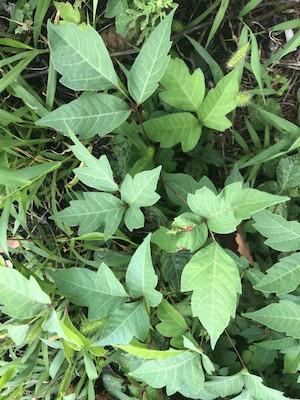 Poison ivy (Toxicodendron radicans) is a common native perennial that can cause contact dermatitis. This member of the cashew family (Anacardiaceae) contains urushiol, a resinous oil, which causes rashes and even blistering in some people. All plant parts contain this oil and symptoms usually appear within 24 hours of exposure. The severity of the reaction depends on the sensitivity of the individual, but typically, a person must be exposed to poison ivy at least once prior to become sensitized and have an allergic reaction.
Poison ivy (Toxicodendron radicans) is a common native perennial that can cause contact dermatitis. This member of the cashew family (Anacardiaceae) contains urushiol, a resinous oil, which causes rashes and even blistering in some people. All plant parts contain this oil and symptoms usually appear within 24 hours of exposure. The severity of the reaction depends on the sensitivity of the individual, but typically, a person must be exposed to poison ivy at least once prior to become sensitized and have an allergic reaction.
How to Identify
Poison ivy can be difficult to identify due to the variability of its growth habit and appearance. The leaves of poison ivy always have 3 leaflets with the middle leaflet being the largest and on a longer stem or petiolule. The other two leaflets are smaller, often asymmetrical, and connect directly to the leaf stem or petiole. Leaves can be glossy, may have smooth or notched margins, can range from green to red in color. Poison ivy lacks thorns and its leaves grow in an alternate arrangement.
Poison ivy is a woody vine, but can also grow as ground cover or look similar to a tree or shrub with support. The vine can grow to over 75 feet long and has dark brown to black wiry roots along the stem.
What to do if you encounter it
If you come into contact with poison ivy, immediately wash the affected area with soap and cool water and avoid touching your eyes. Do NOT burn poison ivy. The smoke produced can cause rashes on/in the skin, eyes, throat, and lungs.
Management
Poison ivy is effectively managed with herbicides. Many of the herbicides labeled for poison ivy contain glyphosate, a non-selective, systemic herbicide. Foam-based delivery methods and formulations are available and allow for more precise applications. Always consult and follow the label instructions as the label is the law. Poison ivy can also be mechanical removed. Mowing is NOT an acceptable means to manage this plant.
Whenever working near poison ivy, wear protective clothing including long pants, a long-sleeve shirt, closed toed shoes, and gloves. When removing this plant, change clothes frequently and wash contaminated clothing separately.
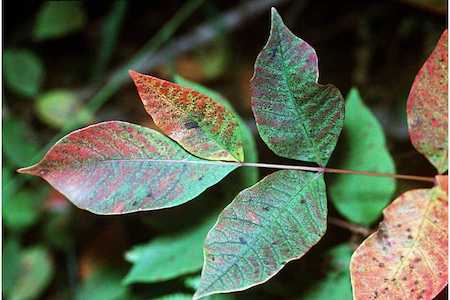 Poison sumac (Toxicodendron vernix) is a native perennial that grows in very wet or flooded soils such as bogs, swamps, and marshes. Like poison ivy and poison oak, poison sumac contains urushiol, a resinous oil, which causes rashes and even blistering in some people. All plant parts contain this oil. Compared to poison ivy, poison sumac is fairly uncommon and typically occurs individually rather than in clonal groups.
Poison sumac (Toxicodendron vernix) is a native perennial that grows in very wet or flooded soils such as bogs, swamps, and marshes. Like poison ivy and poison oak, poison sumac contains urushiol, a resinous oil, which causes rashes and even blistering in some people. All plant parts contain this oil. Compared to poison ivy, poison sumac is fairly uncommon and typically occurs individually rather than in clonal groups.
How to Identify
Poison sumac is a shrub or small tree that can grow to 30 feet tall. It has grey bark which darkens as the plant ages and large pinnate leaves. Each leaf has 7 to 13 leaflets which are smooth, entire, can have a reddish hue, and are connected to a red stem. The flowers of poison sumac are yellow and clustered. The resulting berries are small and white like those of poison ivy.
What to do if you encounter it
If you come into contact with poison sumac, immediately wash the affected area with soap and cool water and avoid touching your eyes. Do NOT burn poison sumac. The smoke produced can cause rashes on/in the skin, eyes, throat, and lungs. In addition, the inhalation of the smoke can cause diarrhea.
Management
Poison sumac can be managed through hand pulling, cutting, and herbicide application. Mowing should NOT be used to control this plant. Whenever working near poison sumac, wear protective clothing including long pants, a long-sleeve shirt, closed toed shoes, and gloves. When removing this plant, change clothes frequently and wash contaminated clothing separately.
Many of the herbicides labeled for poison sumac contain glyphosate, a non-selective, systemic herbicide. Foam-based delivery methods and formulations are available and allow for more precise applications. Only apply herbicides labeled for poison sumac control. Always consult and follow the label instructions as the label is the law.
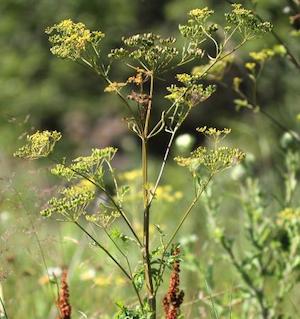 Wild parsnip (Pastinaca sativa) is an invasive weed commonly found in fields and along roadsides. The sap of wild parsnip contains furanocoumarins which can cause photodermatitis when combined with sunlight. Contact with the sap can cause severe burns, blisters, and photosensitivity. Similar to but not as severe as burns from giant hogweed, affected areas can remain sensitive to sunlight for up to 2 years.
Wild parsnip (Pastinaca sativa) is an invasive weed commonly found in fields and along roadsides. The sap of wild parsnip contains furanocoumarins which can cause photodermatitis when combined with sunlight. Contact with the sap can cause severe burns, blisters, and photosensitivity. Similar to but not as severe as burns from giant hogweed, affected areas can remain sensitive to sunlight for up to 2 years.
How to Identify
Wild parsnip is a biennial and grows to 4 to 5 feet tall. It has smooth, hollow stems and large, toothed compound leaves, each of which has 3 to 5 leaflets. The leaves look like large celery leaves. Emblematic of the carrot family (Apiaceae), the inflorescence of wild parsnip is an umbel. It ranges from 3 to 8 inches across and is topped with yellow flowers. For its first year, wild parsnip grows as a rosette. Flowering typically occurs in its second year in May or June and lasts 1 to 2 months.
What to do if you encounter it
If you come into contact with wild parsnip, wash the affected area immediately with soap and cool water and keep the area away from sunlight for 48 hours. If a reaction occurs, keep the affected area out of sunlight and contact your physician.
While wild parsnip is not subject to state of federal removal programs in NYS, infestation can still be reported to New York iMapInvasives to add to the state's invasive species location database.
Management
It is best to manage wild parsnip while patches are small and not well established. Whenever interacting with this plant, wear protective clothing including long pants, a long-sleeve shirt, closed toed shoes, and gloves and try to avoid contact with the sap.
Wild parsnip can be managed through hand pulling, mowing, cutting its roots, and applying herbicides. Plants should be pulled or have their roots cut before they have gone to seed. Once the plant has set seed, cut off the heads, place them in a plastic bag, and leave them in the sun for at a least a week before disposal. The best time to mow wild parsnip is after bloom, but before seed development. A single mowing will often kill the plant, but repeated mowing may be necessary if the plant resprouts.
Several herbicides effectively control wild parsnip. These include glyphosate, triclopyr, and 2,4-D which can be applied as spot treatments to wild parsnip rosettes. Only apply herbicides labeled for wild parsnip control. Always read the label instructions before applying an herbicide. Remember, the label is the law!
- To report an infestation of wild parsnip:
- Take a picture of the whole plant and close-ups of the leaf, inflorescence, and seed if present.
- Make note of the location (GPS coordinates, road intersection, or landmarks).
- Report the infestation to New York iMapInvasives.
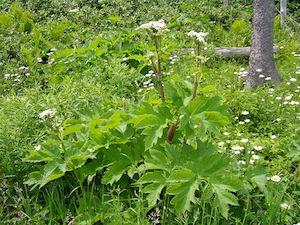 Cow parsnip (Heracleum maximum) is a native biennial that can cause rashes, burns, and blisters. It grows in a range of habitats including roadsides, open fields, woodlands, and river and stream banks. Like giant hogweed and wild parsnip, the sap of cow parsnip contains furanocoumarins which can cause photodermatitis when combined with sunlight. Exposure to the sap can cause severe burns and photosensitivity though the sap is less severe than that of giant hogweed. In addition, the affected area can take weeks to months to heal, leave scars, and remain sensitive to sunlight for months to years.
Cow parsnip (Heracleum maximum) is a native biennial that can cause rashes, burns, and blisters. It grows in a range of habitats including roadsides, open fields, woodlands, and river and stream banks. Like giant hogweed and wild parsnip, the sap of cow parsnip contains furanocoumarins which can cause photodermatitis when combined with sunlight. Exposure to the sap can cause severe burns and photosensitivity though the sap is less severe than that of giant hogweed. In addition, the affected area can take weeks to months to heal, leave scars, and remain sensitive to sunlight for months to years.
How to Identify
Cow parsnip can grow to over 6 feet tall. It has erect stems that are covered in coarse hairs and large, lobed leaves that can be 20 inches across. Like other members of the carrot family (Apiaceae), cow parsnip's flowers grow in umbels which are about 8 inches across and produce white flowers. For its first year, cow parsnip grows as a rosette. It typically blooms in its second year from May to June. Cow parsnip is less common than wild parsnip in NYS and is more commonly found in cooler parts of the state. Cow parsnip is commonly confused for giant hogweed; however, cow parsnip is smaller and lacks the purple splotches found on giant hogweed's stems.
What to do if you encounter it
If you come into contact with cow parsnip, wash the affected area immediately with soap and cool water and keep the area away from sunlight for 48 hours. If a reaction occurs, keep the affected area out of sunlight and contact your physician.
Management
It is best to manage cow parsnip while patches are small and not well established. Whenever interacting with this plant, wear protective clothing including long pants, a long-sleeve shirt, closed toed shoes, and gloves and try to avoid contact with the sap.
Cow parsnip can be managed through hand pulling and herbicide application. Cow parsnip should be pulled when patches are small and before it goes to seed. Only apply herbicides labeled for cow parsnip control. Always read the label instruction before applying an herbicide. Remember, the label is the law!
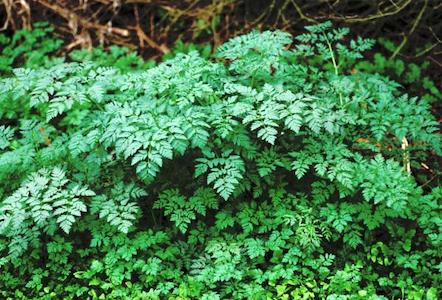 Poison hemlock (Conium maculatum) is an invasive herbaceous biennial commonly found in pastures and along roadsides, field edges, and irrigation ditches. This plant is very toxic to humans, cattle, sheep, and other livestock. All plant parts are poisonous.
Poison hemlock (Conium maculatum) is an invasive herbaceous biennial commonly found in pastures and along roadsides, field edges, and irrigation ditches. This plant is very toxic to humans, cattle, sheep, and other livestock. All plant parts are poisonous.
How to Identify
Poison hemlock is a member of the carrot family (Apiaceae). It grows as a rosette in its first year and produces flowering stems in the following year. It grows 3 to 8 feet tall, but can reach up to 12 feet in height. Poison hemlock has smooth, hollow stems that are usually covered with red or purple blotches. Its leaves are finely dissected, toothed, and have a strong smell when crushed. The inflorescence is an umbel, each of which is 4 to 8 inches across and contains several small, white flowers in clusters.
Poison hemlock is commonly mistaken for wild carrot (Daucus carota). Wild carrot, however, is hairy, typically half the size of poison hemlock, and lacks purples streaks on its stems. In addition, poison hemlocks leaves are less divided than wild carrot.
What to do if you encounter it
If you encounter poison hemlock, do NOT consume any parts of this plant. Do NOT burn poison hemlock. In addition, do not allow any animal to ingest dead or living poison hemlock plants as all plant parts are highly toxic to mammals. Manageme
Management
Whenever interacting with this plant, wear protective clothing including long pants, a long-sleeved shirt, closed toed shoes, and gloves. Poison hemlock can be managed through hand pulling and herbicide application. It is best to hand weed poison hemlock infestations when they ar
If possible, remove the entire taproot to reduce the possibility of resprouting. Do NOT put pulled plants into compost piles or in areas that are accessible to children or livestock. Plant parts remain poisonous even when dried. Instead, put all pulled plant parts into a bag and dispose of them.
Several herbicides effectively control poison hemlock including glyphosate and 2,4-D. They are most effective when applied to young and in the rosette stage. Only apply herbicides labeled for poison hemlock. Always read the label instruction before applying an herbicide. Remember, the label is the law.
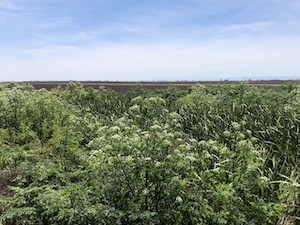 Water hemlock (Cicuta maculata) is an extremely toxic, wetland plant native to North America. It is found in swamps, wet meadows, ditches, and along stream banks. It is one of the most poisonous plants found in North America, harming humans and livestock. Within a hour of ingestion, water hemlock can cause nausea, convulsions, abdominal pain seizures, vomiting, and often death. All plant parts are poisonous. Though sometimes confused with poison hemlock, water hemlock is more toxic and prefers wetter soil conditions.
Water hemlock (Cicuta maculata) is an extremely toxic, wetland plant native to North America. It is found in swamps, wet meadows, ditches, and along stream banks. It is one of the most poisonous plants found in North America, harming humans and livestock. Within a hour of ingestion, water hemlock can cause nausea, convulsions, abdominal pain seizures, vomiting, and often death. All plant parts are poisonous. Though sometimes confused with poison hemlock, water hemlock is more toxic and prefers wetter soil conditions.
How to Identify
This member of the carrot family (Apiaceae) is a biennial/perennial and grows to 3 to 6 feet tall. It has smooth, hollow stems mottled with reddish purple splotches or strips. Its leaves are pinnately compound and finely divided. Unlike other species in the carrot family, the veins on water hemlock leaflets end in the notch between teeth. Water hemlock produces small, white flowers in umbels. The umbels are about 6 inches across. The root system is composed of several fleshy, oblong roots. While the entire plant is toxic, the fleshy roots are extremely poisonous.
What to do if you encounter it
If you encounter water hemlock, do NOT consume any parts of this plant. In addition, do not allow any animal to ingest dead or living water hemlock plants as all plant parts are highly toxic to mammals. If you hand comes into contact with the plant, particularly the roots, wash them immediately before touching your eyes or mouth.
Management
Whenever interacting with this plant, wear protective clothing including long pants, a long-sleeved shirt, closed toed shoes, and gloves. Water hemlock can be managed through mechanical and chemical means. It can be hand pulled or mowed. Be careful to pull up the entire plant including the roots. Do NOT dispose of pulled plants in a compost pile or anywhere easily accessible to children or animals. Instead, dispose of pulled water hemlock plants in a garbage bag.
Only apply herbicides labeled for water hemlock. Always read the label instruction before applying an herbicide. Remember, the label is the law. Herbicide applications are most effective in late spring or early summer.
